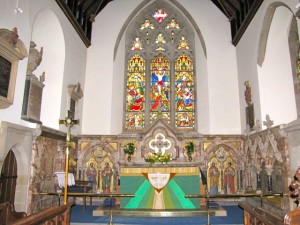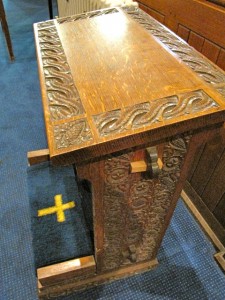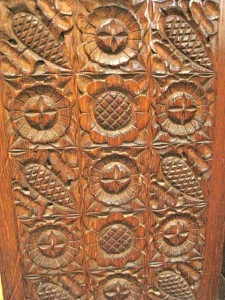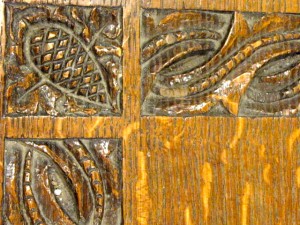So, now that Juliette Gordon Low: The Remarkable Founder of the Girl Scouts is out and some of you (I hope!) are reading it, I think it’s time to provide even more background and observations that could not go in the book. This week’s topic is Valentine Eliot, that remarkable vicar’s wife from Wellesbourne, Warwickshire, U.K.
Mrs. Eliot was a woodworker. I have no direct proof that she and Juliette “Daisy” Gordon Low knew each other–but I find it difficult to believe they did not. Valentine Elliot’s husband was the priest in charge of St. Peter’s Church, which Daisy and William Mackay Low attended while they lived in Wellesbourne House from 1889 to early in the next century (Willy Low died in 1905). Because of Willy’s extended hunting trips, racing weekends, and visits to spas without her, Daisy was left ever more frequently to her own devices.
We know that Daisy carved a mantel for Willy’s smoking room in Wellesbourne House. But when did she learn woodworking? If it was before arriving in Wellesbourne, then surely their common interest drew the two women together. Or perhaps she learned it while living Wellesbourne. Perhaps Valentine Eliot actually taught Daisy Low the craft of wood carving.
Valentine Eliot was such a prodigious wood carver that she opened and ran a shop brimming with her art. According to Wellesbourne historian Peter Bolton, the intrepid Mrs. Eliot seems to have been undaunted by projects large (the St. Peter’s Church doors) or small (hymn boards). Woodcarving was not a hobby considered entirely suitable for women, so most people who knew of her no doubt thought her a little quirky. Did this quality draw Daisy to her? Did the two women carve in companionable and contemplative silence side by side? Did they murmur together about their absent husbands, filling the time on their hands with creative work? Or did they impatiently push aside the duties that claimed them, and rush to Mrs. Eliot’s studio and to their shared joy in their projects and each other’s company?
We’ll never know.
We’ll also never know what Valentine Eliot’s woodwork looked like, nor what calibre of artist she was. The church doors are long gone, and none of the carved wood in St. Peter’s today bears her name or initials. It is just as likely that she never signed any of her art.
However, when I was in Wellesbourne last summer, I walked through St. Peter’s Church in the company of Peter Bolton and his wife and fellow-researcher Rosalind Bolton.
I was suddenlly arrested by the sight of an ornately carved wooden prie dieu:
I could find no artist’s signature nor mark. The carving was beautiful, but rough–not like a master craftsman, but like an exceptionally skilled amateur.
Of course I wondered whether this prie dieu could be the handiwork of Valentine Eliot.
Peter Bolton thought it could be. I think it could be.
We cannot prove it, alas. But with the Boltons’ expertise backing up my hunch, I found it very exciting to contemplate. This might be the work of Valentine Eliot. And Valentine Eliot might have been Daisy Low’s teacher or colleague in the unconventional craft of woodworking.
For more views of St. Peter’s Church from our day there, see Clive Hanley’s photographs. Be sure to look at the memorial tablet to Willy Low. Click here.






Stacy,
It was SO good to be able to meet you and to hear your talk at the annual meeting of Girl Scouts of Northern IL. I LOVED your talk. I was sure I had much new to learn about Daisy, and I enjoyed your speculations about the impact of deafness on Daisy’s life and work.
I love your analysis that being labeled “crazy” may have helped her manage in society, but has also permitted historians to completely dismiss her as an important person in American life. Indeed, knowing as I do the lifelong impact of Girl Scouting on participants, I know she did, in fact, change the world. It’s wonderful to know that you think so too.
Love the woodcarving tidbit. I can’t wait to wade into your book which Kristie so thoughtfully sent me.
Ruth Little
Thank you so much, Ruth! It was grand to meet you, too. I appreciate the kind words about my analysis of Juliette Low, and I certainly hope you enjoy the book!